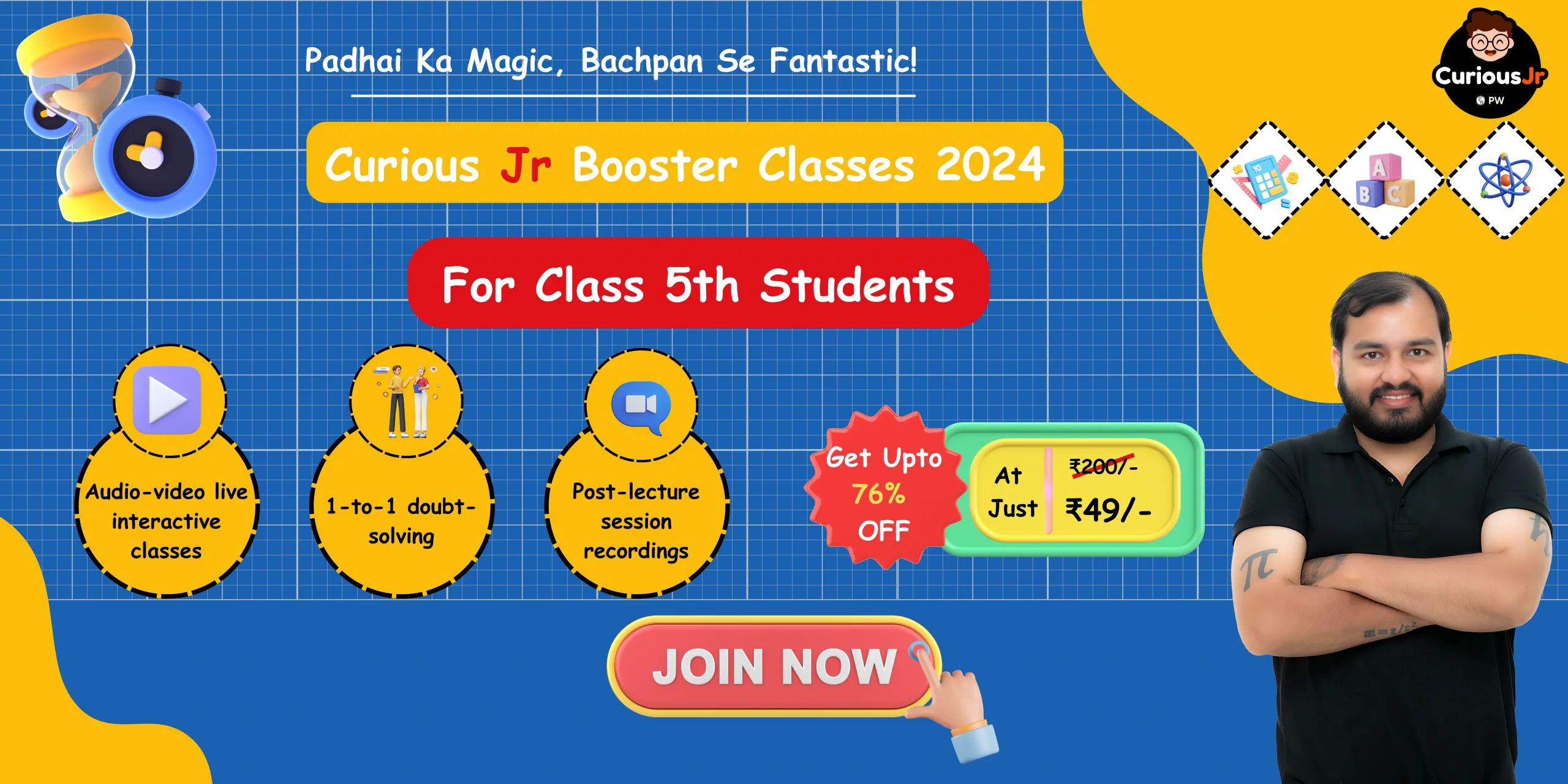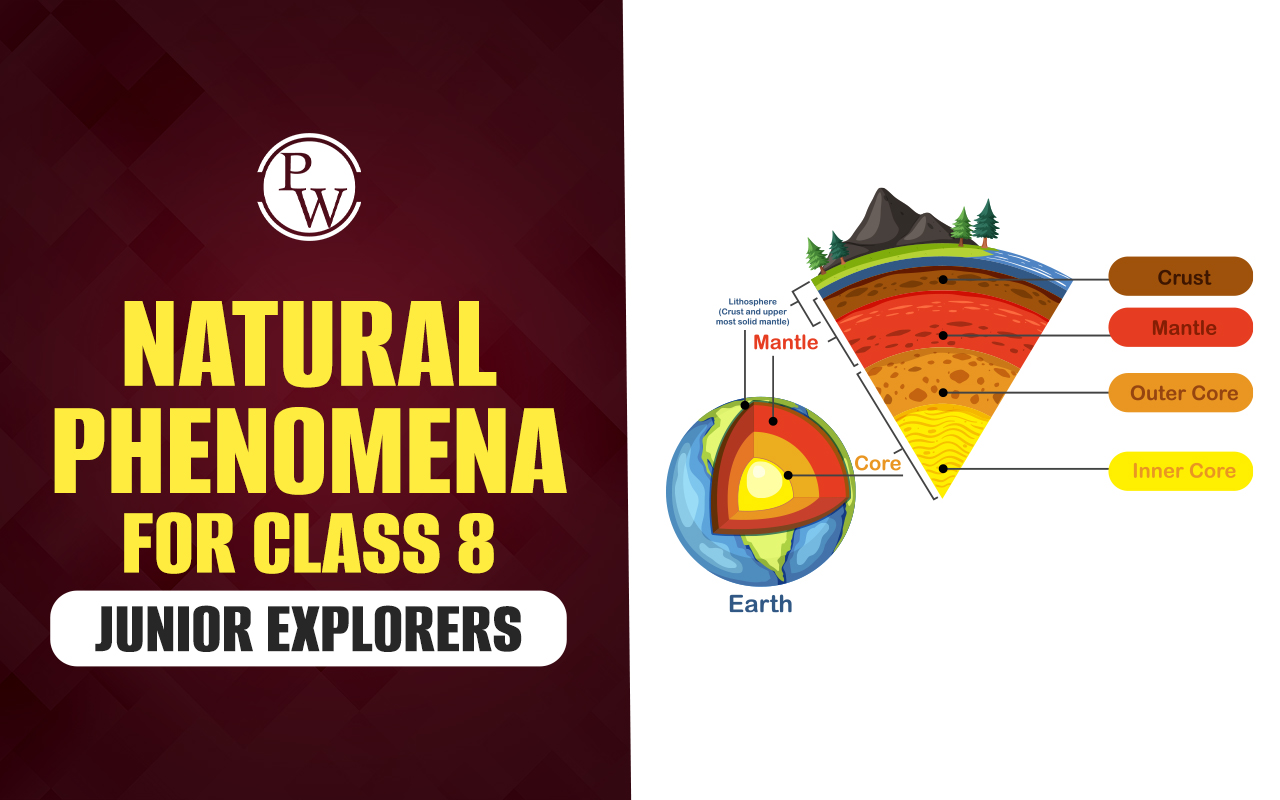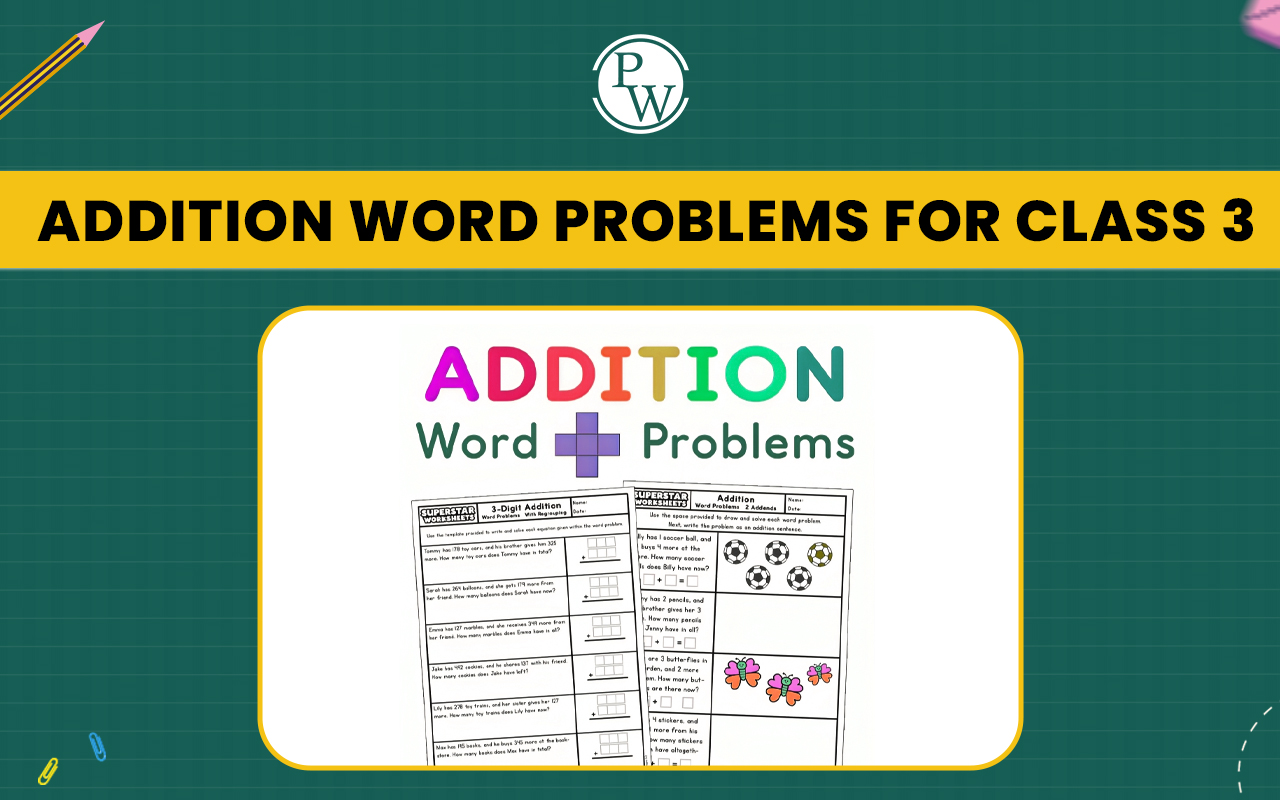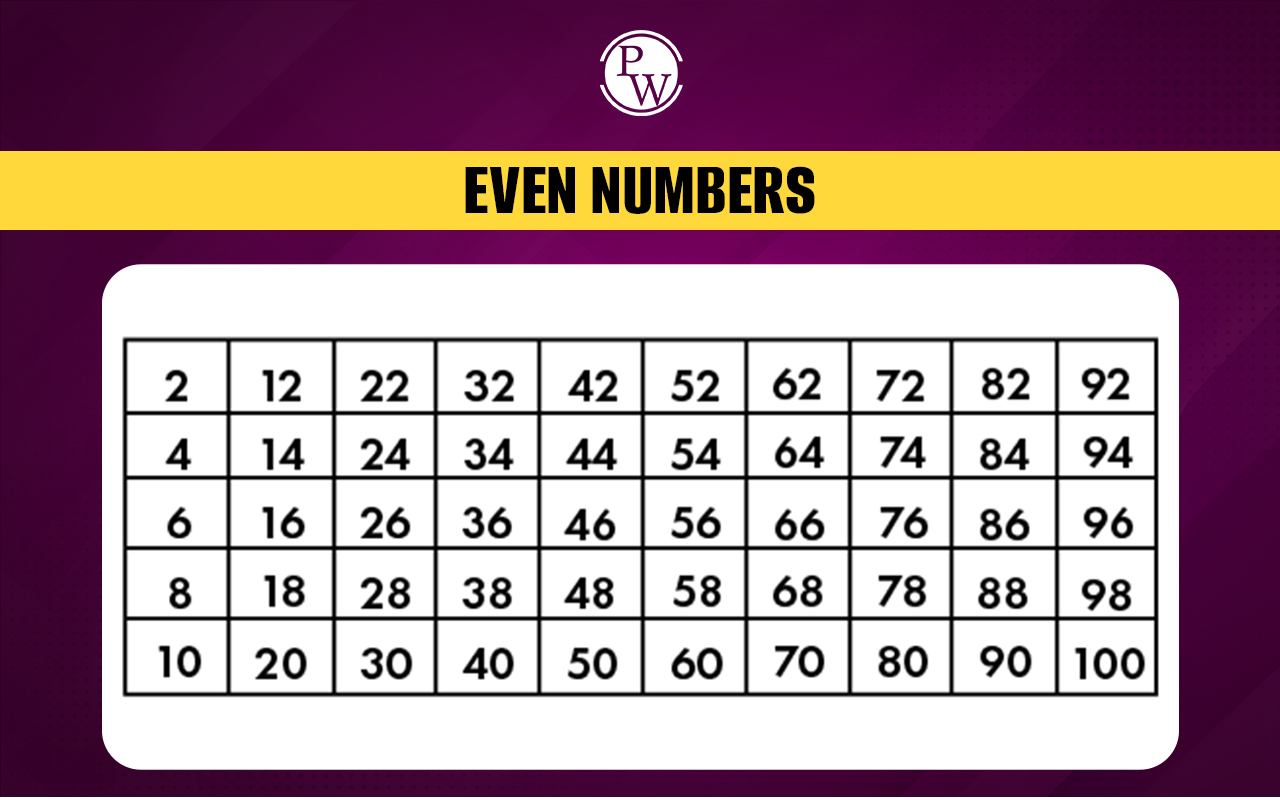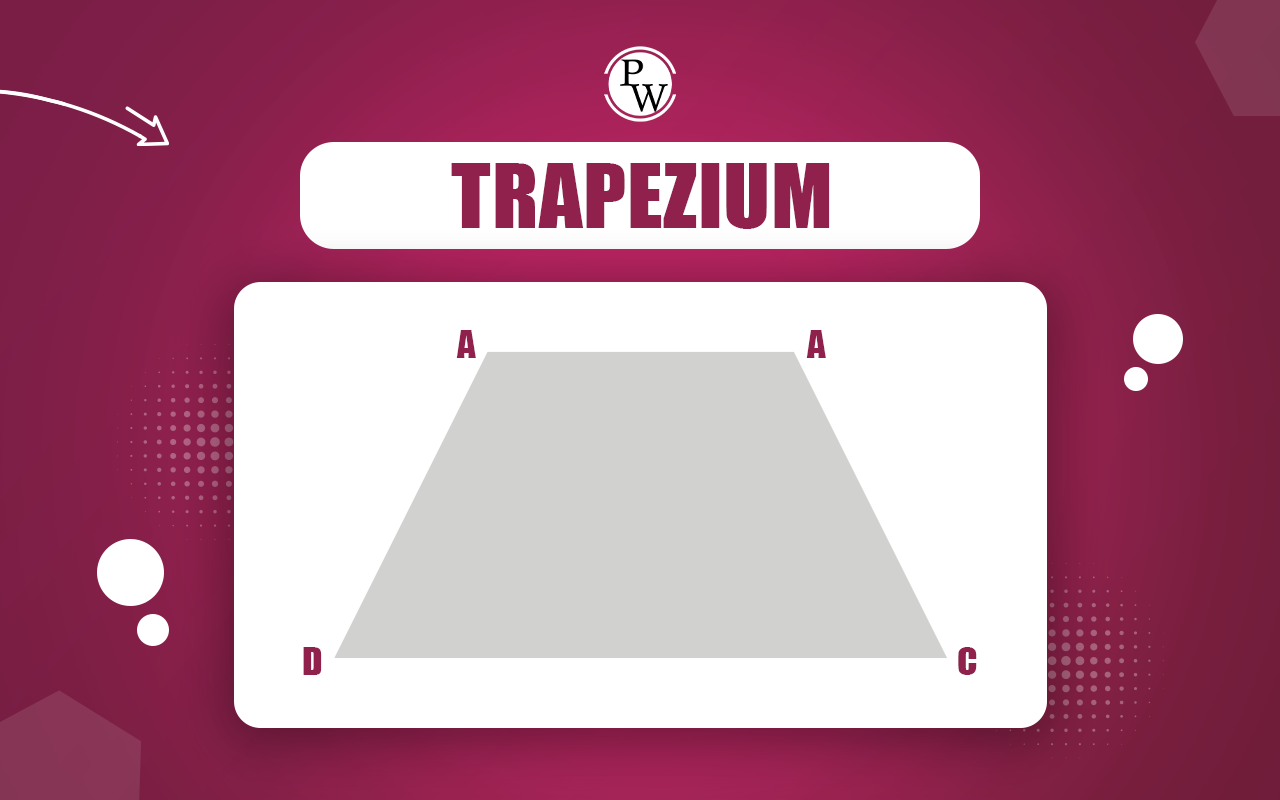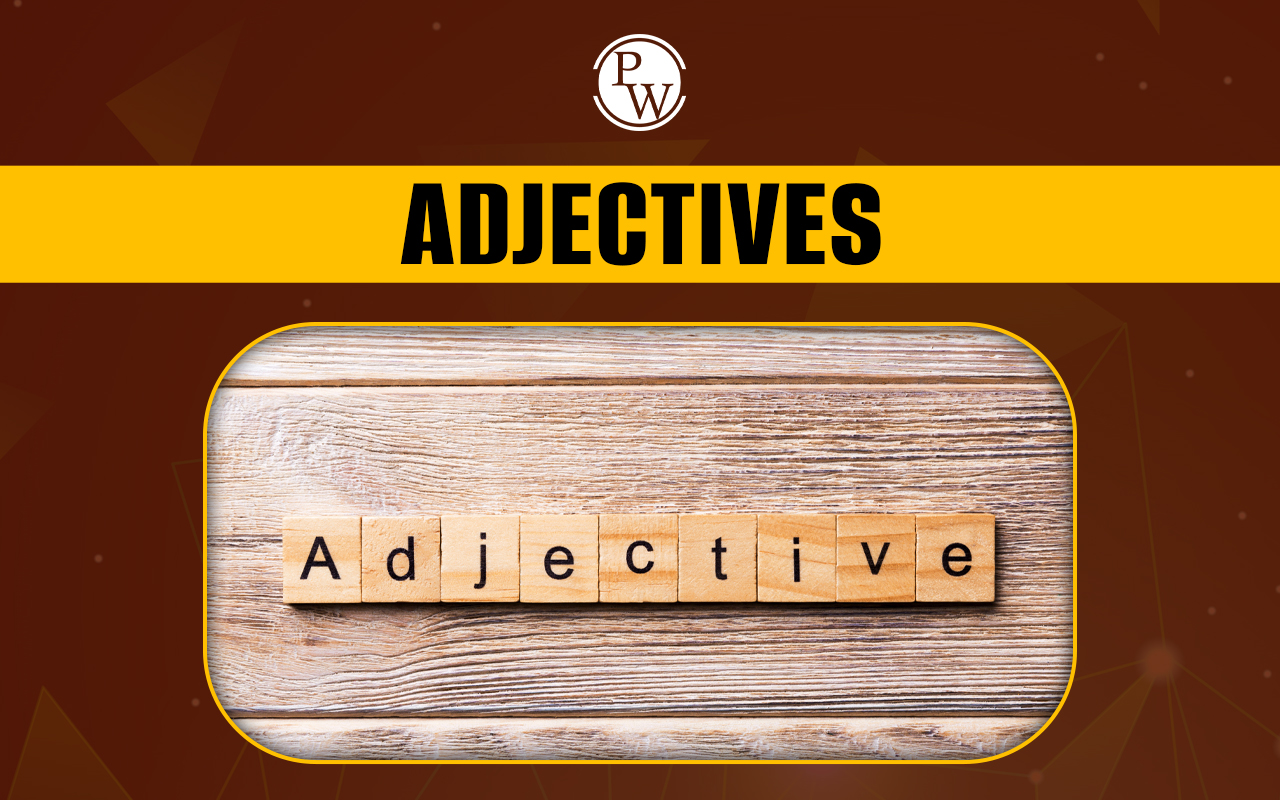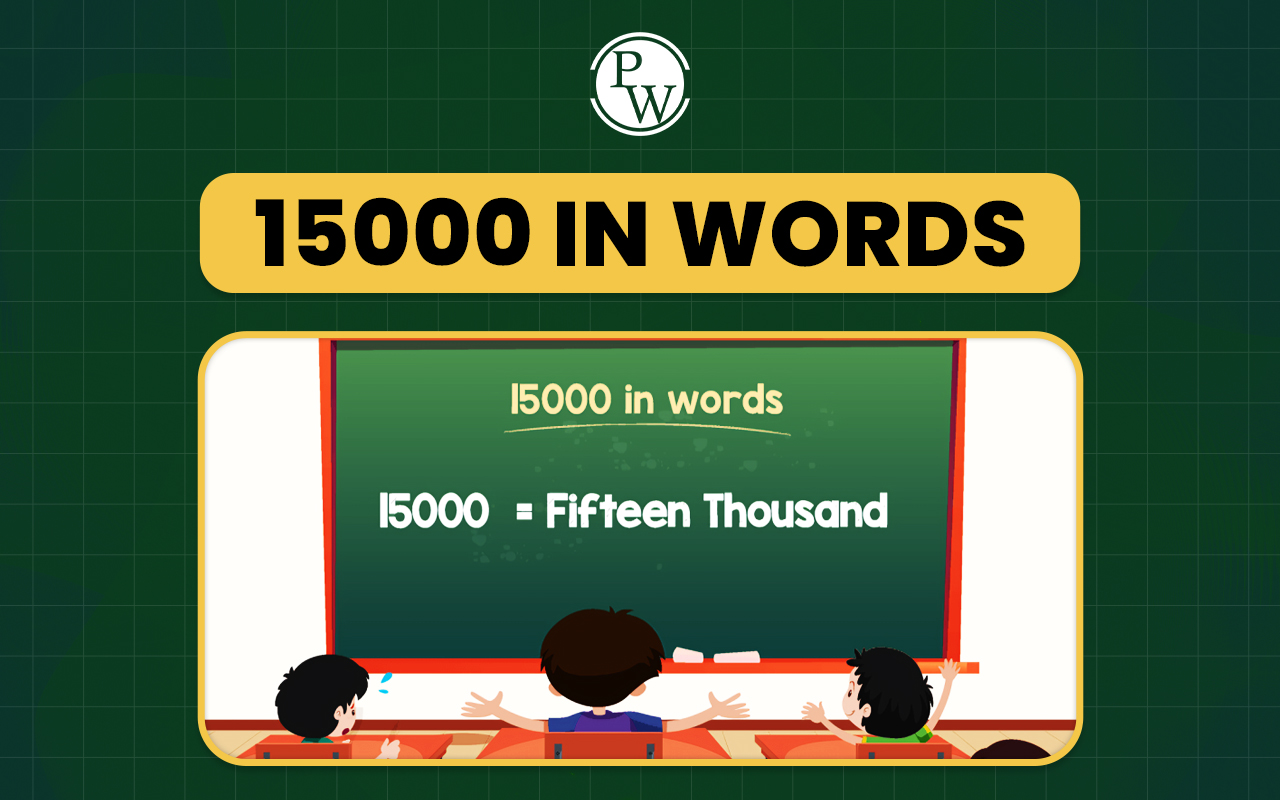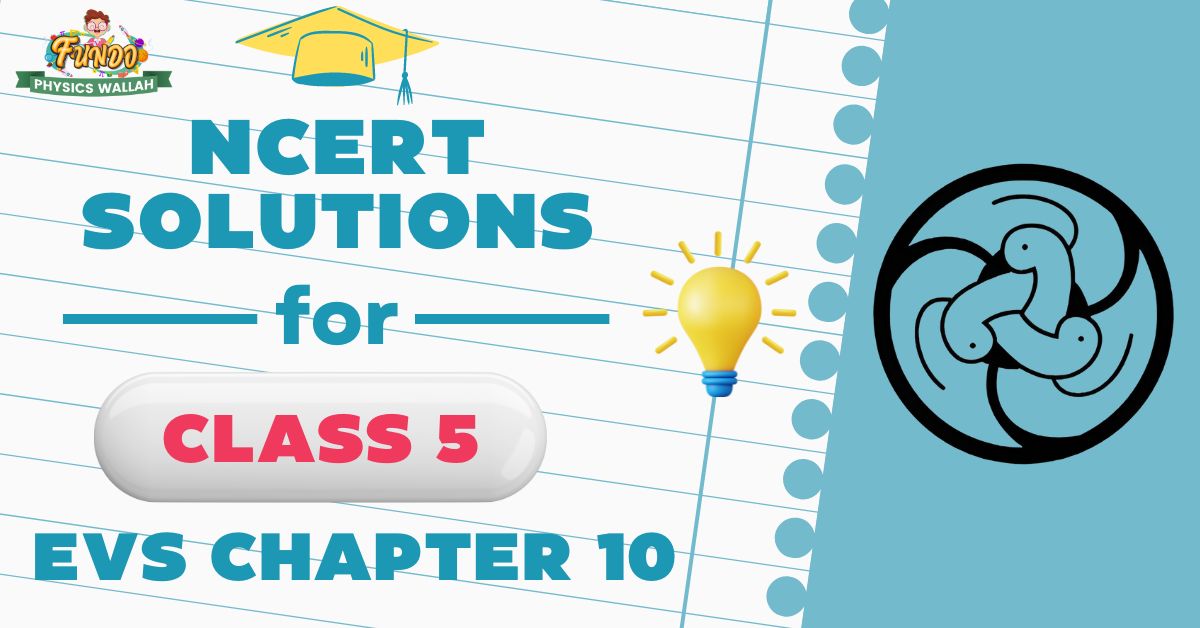
NCERT Solutions for Class 5 EVS Chapter 10
NCERT Solutions for Class 5 EVS Chapter 10 : Embark on a historical journey with 'Walls Tell Stories' in Chapter 10 of Class 5 EVS, crafted to engage students with the rich legacy of Golconda Fort's architecture. Physics Wallah's lucid solutions lead young minds through the fort's formidable defences, exquisite designs, and notable past. Delving into the NCERT Class 5 book's vivid recounting of history is crucial for learners striving for academic excellence. Physics Wallah offers thorough NCERT Solutions for Class 5 EVS Chapter 10, aligned with the CBSE curriculum, assisting students as they navigate educational pursuits and igniting enthusiasm for our cultural heritage.NCERT Solutions for Class 5 EVS Chapter 10 Overview
Explore the echoes of history with Physics Wallah's NCERT Solutions for Class 5 EVS Chapter 10. This chapter demystifies the architectural marvels and strategic genius of the Golconda Fort, offering a treasure trove of information for inquisitive minds. Each segment of the chapter is meticulously explained, with vibrant illustrations bringing the fort's stories to life and deepening students' connection with India's heritage. Physics Wallah ensures learning is a captivating quest, transforming every aspect of EVS into a practical learning experience. Chapter 10 takes students on a historical exploration of Golconda Fort, encouraging them to interact with the fort's past and its role in shaping history. Visit PW's official website to gain complete access to the NCERT Solutions for Class 5 EVS Chapter 10, curated for straightforward understanding and comprehensive analysis. Dive into the chapter, consolidate knowledge with varied activities, and utilize the chat support for immediate assistance and academic advancement.NCERT Solutions for Class 5 EVS Chapter 10 PDF Download
NCERT Solutions for Class 5 EVS Chapter 10 'Walls Tell Stories' provide detailed, curated insights into the historical marvel of Golconda Fort, nurturing a sense of discovery among young learners. These solutions facilitate a deep understanding and readiness for academic assessments, crucial for educational advancement. The chapter intricately explores the fort's grand architecture, robust fortifications, exquisite wall designs, and its profound historical importance. As a valuable guide for CBSE Class 5 students, it stresses the significance of appreciating our cultural heritage. This narrative equips students with key learning tools to thoroughly decode the stories that the ancient walls of Golconda Fort narrate, underscoring its timeless beauty and significance in our history.NCERT Solutions for Class 5 EVS Chapter 10 Walls Tell Stories
Embark on an enthralling journey through time with NCERT Solutions for Class 5 EVS Chapter 10 'Walls Tell Stories'. Transforming the intricate tales of Golconda Fort into accessible lessons, these solutions help Class 5 students connect with the grandeur of historical architecture and the narratives it preserves. Each question from the Chapter 10 exercises is meticulously answered, smoothing the path for both learning and exam preparation. Crafted by experts in education, the solutions are clear, accurate, and reliable, ensuring a seamless and captivating learning experience for every young historian.NCERT Solutions for Class 5 EVS Chapter 10 Page no: 88
Think:- Why were bastions made in the fort wall?
- Why were big holes made in them?
- What difference would be there if you were to look from a straight flat wall or a bastion at a height? How would the soldiers find peeping from the holes in the bastions useful while attacking?
Related Links -
NCERT Solutions for Class 5 EVS Chapter 10 Page no: 89
Think and discuss:- How would the fountains have worked?
- What arrangements would have been made in the building for air and light?
- Look carefully at the picture of the beautiful carving on the wall. What kind of tools would have been used for such fine carving?
- We still do not have any electricity at many places in our country. Even at places which do have electricity, imagine what would happen if there was no electricity for one week. What are the things that would be difficult to manage without it?
NCERT Solutions for Class 5 EVS Chapter 10 Page no: 90
Tell: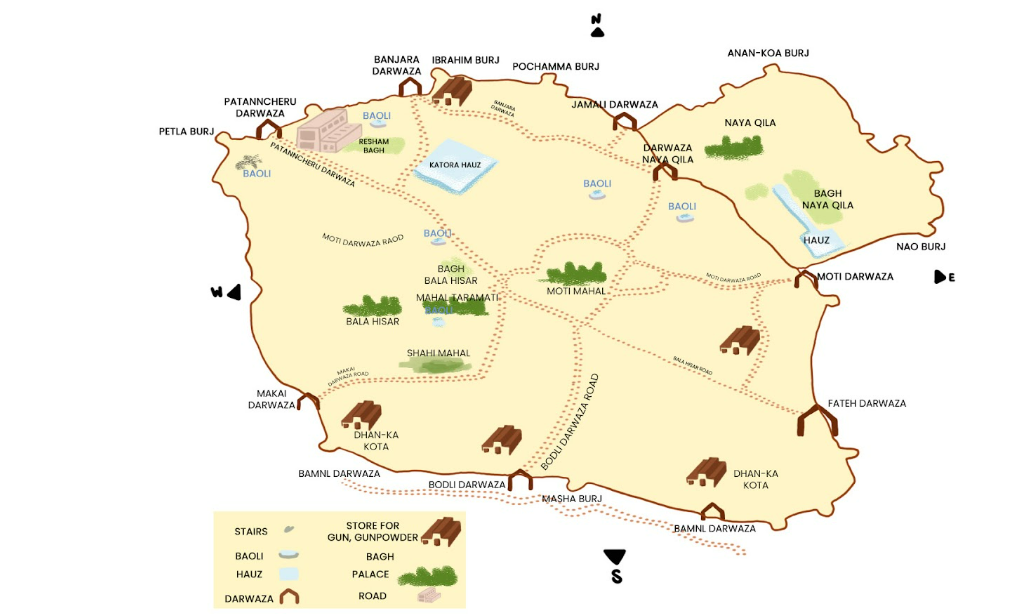 Look carefully at the map of Golconda. On the map, arrows show all the four directions.
(a) If you are peeping inside from Bodli Darwaza, in which direction from you is Katora Hauz?
Solution
:
When looking from Bodli Darwaza, you'll find Katora Hauz towards the north.
(b) If someone is entering from Banjara Darwaza, in which direction from her is Katora Hauz?
Solution:
Upon entering through Banjara Darwaza, Katora Hauz will be located to the south.
(c) In which direction will you walk from Bala Hisar to reach Moti Mahal?
Solution:
To get to Moti Mahal from Bala Hisar, one would head east.
(d) How many gates can you see on the outer walls of the fort?
Solution:
Scanning the fort's perimeter reveals a total of nine gates.
(e) Count how many palaces are there in the fort?
Solutions:
Within the confines of the fort, one can count three palaces.
(f) What arrangements for water can you see inside the fort? For example, wells, tanks, stepwells. On the map, 1 cm distance is equal to a distance of 110 metres on the ground.
Solution:
Inside the fort, there are five baolis (step wells) and three hauz (water tanks) available for water storage.
On the map, 1 cm distance is equal to a distance of 110 metres on the ground. Now tell
On the map the distance between Bala Hisar and Fateh Darwaja is ____ cm. On the ground, the distance between the two would be ____ metres
Solution:
Measured on the map, the gap between Bala Hisar and Fateh Darwaja spans 8 cm. In real life, this translates to a distance of 880 meters.
How far is Makai Darwaza from Fateh Darwaza?
Solution:
The stretch between Makai Darwaza and Fateh Darwaza covers 12 cm on the map, which equals 1320 meters on the actual ground.
Look carefully at the map of Golconda. On the map, arrows show all the four directions.
(a) If you are peeping inside from Bodli Darwaza, in which direction from you is Katora Hauz?
Solution
:
When looking from Bodli Darwaza, you'll find Katora Hauz towards the north.
(b) If someone is entering from Banjara Darwaza, in which direction from her is Katora Hauz?
Solution:
Upon entering through Banjara Darwaza, Katora Hauz will be located to the south.
(c) In which direction will you walk from Bala Hisar to reach Moti Mahal?
Solution:
To get to Moti Mahal from Bala Hisar, one would head east.
(d) How many gates can you see on the outer walls of the fort?
Solution:
Scanning the fort's perimeter reveals a total of nine gates.
(e) Count how many palaces are there in the fort?
Solutions:
Within the confines of the fort, one can count three palaces.
(f) What arrangements for water can you see inside the fort? For example, wells, tanks, stepwells. On the map, 1 cm distance is equal to a distance of 110 metres on the ground.
Solution:
Inside the fort, there are five baolis (step wells) and three hauz (water tanks) available for water storage.
On the map, 1 cm distance is equal to a distance of 110 metres on the ground. Now tell
On the map the distance between Bala Hisar and Fateh Darwaja is ____ cm. On the ground, the distance between the two would be ____ metres
Solution:
Measured on the map, the gap between Bala Hisar and Fateh Darwaja spans 8 cm. In real life, this translates to a distance of 880 meters.
How far is Makai Darwaza from Fateh Darwaza?
Solution:
The stretch between Makai Darwaza and Fateh Darwaza covers 12 cm on the map, which equals 1320 meters on the actual ground.
NCERT Solutions for Class 5 EVS Chapter 10 Page no: 93
Discuss:- Have you recently read or heard about any country attacking or going to war with another country?
- Find out what was the reason for this war.
- What kind of weapons were used in this war?
- What kind of destruction was caused because of this?
- Have you seen anything made of bronze? What?
- Tribal people have used bronze to make many things for thousands of years. One wonders how they took out copper and tin from the deep mines, melted these metals, and turned them into beautiful things!
- Find out from your elders about some of the things made from bronze that were, or are still used in your house. From its colour try to identify which one of them is made from copper, which from brass, and which from bronze.
NCERT Solutions for Class 5 EVS Chapter 10 Page no: 94
Arrangements for water: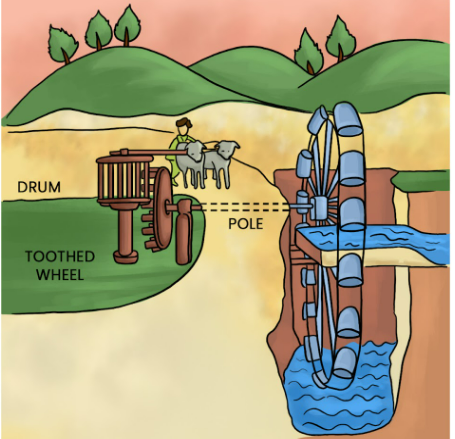 Look, this pole shown under the ground joins with another wheel which has a number of pots on it.
Look, this pole shown under the ground joins with another wheel which has a number of pots on it.
- Now imagine, how would this garland of pots lift water from the well?
- Do you now get some idea about how the tanks could have been filled by lifting water from the wells? Even today we can see clay pipes in the walls of the fort. These pipes would have been used to carry water to different places in the palace.
- Where else have you seen such wheels attached to each other. For example, in the gear of a cycle or somewhere else?
- Look around and find out how water is pumped up from the ground to higher places?
- How is water pumped up using electricity? How is water lifted without electricity?
NCERT Solutions for Class 5 EVS Chapter 10 Page no: 95
Close your eyes and go back in time! Imagine that you are in those days when there was a busy town inside Golconda. Think about the questions given below and discuss in class. You could even put up a play.- What is the Sultan doing in the palace? What kind of clothes is he wearing? What dishes are being offered to him? But why does he seem so worried? And in what language is he talking?
- Imagine the rooms in the palace—the beautiful carpets and curtains, the fountains on the terrace… and the sweet smell of roses and chameli—where is this coming from?
- What are the different kinds of factories you can see? How many people are working there? What are they doing? What are they wearing? How long do you think they work?
- Look there! See how finely those craftsmen are carving the stones using a chisel and hammer? Can you see the stone dust in the air. Do you think this stone dust would harm them in some way?
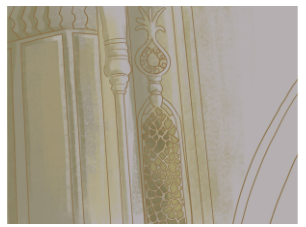 Solution:
Artisans are skillfully chiselling stone, creating a haze of dust. They've covered their faces to protect against the dust while they work.
Solution:
Artisans are skillfully chiselling stone, creating a haze of dust. They've covered their faces to protect against the dust while they work.
NCERT Solutions for Class 5 EVS Chapter 10 Page no: 97
Write:- What kinds of pots have you seen around you?
- Try to find out from your grandparents about the other kinds of pots and pans they used in their time?
- Have you ever been to some museum or heard about it? What all things are there in a museum?
- Is there any old building or monument near your house which people come to see? If yes, name it.
- Have you ever gone to see an old monument? Which was that? Did you feel it told you a story? What could you know about those times from it?
- How old was it? How did you know?________________________________
- What was it made of?________________________________________________
- What colour was it?___________________________________________________
- Were there any special kind of designs on the old building? Draw them in your notebook._______________________________________________________________
- Who used to live there in the olden days?__________________________
- What kinds of activities took place there?__________________________
- Do some people still live there?_____________________________________
Importance of NCERT Solutions for Class 5 EVS Chapter 10
Chapter 10 of Class 5 EVS, 'Walls Tell Stories', takes students on an explorative adventure into the historical depths of Golconda Fort. It reveals insights into the fort's architectural mastery, fortification strategies, and cultural significance, unravelling the stories preserved within its walls. The NCERT solutions for this chapter are essential for developing a nuanced understanding of our past. Developed by educational experts, these resources meticulously walk students through the historical narratives, simplifying the complexity of ancient marvels with clarity and detail. These solutions do more than just provide correct answers; they expand students’ knowledge of history. By connecting textbook information with the tangible remnants of history, they cultivate analytical thinking and a deeper appreciation for our cultural heritage. Engaging with these comprehensive solutions empowers students to appreciate historical architecture as a repository of collective memory and recognize its role in shaping the present and future.Benefits of NCERT Solutions for Class 5 EVS Chapter 10
NCERT Solutions for Class 5 EVS Chapter 10, "Walls Tell Stories," provide invaluable support for students exploring the historical monument of Golconda Fort. Here's how these solutions are beneficial:- Connection to Cultural Heritage: This chapter draws students into the ancient world of Golconda Fort, making its rich history accessible. The solutions guide students through the architectural and historical significance of the fort, instilling essential cultural knowledge.
- Historical Comprehension: By elaborating on the fort's features, from its imposing walls to the lives of its inhabitants, these solutions enhance students' grasp of historical periods and the development of civilizations.
- Analytical Thinking Development: Detailed explanations invite students to think critically about the fort's strategic designs and historical events, sharpening their analytical skills.
- Preparation for Academic Assessments: With comprehensive answers, students are well-equipped to address related questions in exams, bolstering their confidence and readiness for assessments.
- Inspiration for Curiosity: The clear and engaging content resolves ambiguities, motivating students to delve deeper into history and discover more about our collective past.
- Interactive and Engaging Study: The lively descriptions and examples in the solutions make learning about history an interactive and fascinating experience for young learners.
- Curricular Alignment: These solutions, designed in accordance with the CBSE syllabus, ensure that students meet educational standards while enriching their knowledge of India's historical architecture and events.
NCERT Solutions For Class 5 EVS Chapter 10 FAQs
What can 'Walls Tell Stories' teach us?
This chapter takes us through the historical significance of Golconda Fort, teaching us about ancient architecture, defensive strategies, and how these structures tell the story of our past.
Why is it important to learn about historical monuments like Golconda Fort?
Understanding the history and architecture of monuments like Golconda Fort helps us appreciate the richness of our cultural heritage and the advancements in ancient technology.
How do lessons about historical forts benefit students in their learning?
Learning about historical forts enhances students' knowledge of history, cultivates a sense of identity, and fosters respect for the achievements of our ancestors.
What activities can help students learn about historical monuments?
Activities like virtual tours, model building, and creative storytelling enable students to explore and learn about historical monuments in an engaging way.
Why is studying historical structures like Golconda Fort important in environmental studies?
Studying structures like Golconda Fort is crucial in environmental studies as it teaches about sustainable building practices and the impact of historical human settlements on the environment.
Free Learning Resources
PW Books
Notes (Class 10-12)
PW Study Materials
Notes (Class 6-9)
Ncert Solutions
Govt Exams
Class 6th to 12th Online Courses
Govt Job Exams Courses
UPSC Coaching
Defence Exam Coaching
Gate Exam Coaching
Other Exams
Know about Physics Wallah
Physics Wallah is an Indian edtech platform that provides accessible & comprehensive learning experiences to students from Class 6th to postgraduate level. We also provide extensive NCERT solutions, sample paper, NEET, JEE Mains, BITSAT previous year papers & more such resources to students. Physics Wallah also caters to over 3.5 million registered students and over 78 lakh+ Youtube subscribers with 4.8 rating on its app.
We Stand Out because
We provide students with intensive courses with India’s qualified & experienced faculties & mentors. PW strives to make the learning experience comprehensive and accessible for students of all sections of society. We believe in empowering every single student who couldn't dream of a good career in engineering and medical field earlier.
Our Key Focus Areas
Physics Wallah's main focus is to make the learning experience as economical as possible for all students. With our affordable courses like Lakshya, Udaan and Arjuna and many others, we have been able to provide a platform for lakhs of aspirants. From providing Chemistry, Maths, Physics formula to giving e-books of eminent authors like RD Sharma, RS Aggarwal and Lakhmir Singh, PW focuses on every single student's need for preparation.
What Makes Us Different
Physics Wallah strives to develop a comprehensive pedagogical structure for students, where they get a state-of-the-art learning experience with study material and resources. Apart from catering students preparing for JEE Mains and NEET, PW also provides study material for each state board like Uttar Pradesh, Bihar, and others
Copyright © 2025 Physicswallah Limited All rights reserved.
